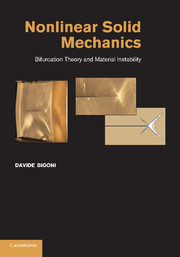Book contents
- Frontmatter
- Contents
- Preface
- Foreword by Giulio Maier
- 1 Introduction
- 2 Elements of tensor algebra and analysis
- 3 Solid mechanics at finite strains
- 4 Isotropic non-linear hyperelasticity
- 5 Solutions of simple problems in finitely deformed non-linear elastic solids
- 6 Constitutive equations and anisotropic elasticity
- 7 Yield functions with emphasis on pressure sensitivity
- 8 Elastoplastic constitutive equations
- 9 Moving discontinuities and boundary value problems
- 10 Global conditions of uniqueness and stability
- 11 Local conditions for uniqueness and stability
- 12 Incremental bifurcation of elastic solids
- 13 Applications of local and global uniqueness and stability criteria to non-associative elastoplasticity
- 14 Wave propagation, stability and bifurcation
- 15 Post-critical behaviour and multiple shear band formation
- 16 A perturbative approach to material instability
- References
- Index
- Plate section
4 - Isotropic non-linear hyperelasticity
Published online by Cambridge University Press: 05 August 2012
- Frontmatter
- Contents
- Preface
- Foreword by Giulio Maier
- 1 Introduction
- 2 Elements of tensor algebra and analysis
- 3 Solid mechanics at finite strains
- 4 Isotropic non-linear hyperelasticity
- 5 Solutions of simple problems in finitely deformed non-linear elastic solids
- 6 Constitutive equations and anisotropic elasticity
- 7 Yield functions with emphasis on pressure sensitivity
- 8 Elastoplastic constitutive equations
- 9 Moving discontinuities and boundary value problems
- 10 Global conditions of uniqueness and stability
- 11 Local conditions for uniqueness and stability
- 12 Incremental bifurcation of elastic solids
- 13 Applications of local and global uniqueness and stability criteria to non-associative elastoplasticity
- 14 Wave propagation, stability and bifurcation
- 15 Post-critical behaviour and multiple shear band formation
- 16 A perturbative approach to material instability
- References
- Index
- Plate section
Summary
We introduce in a simple way the constitutive equations for compressible and incompressible hyperelastic materials, isotropic in their unstressed configuration. Several specific constitutive models are given: the so-called Kirchhoff-Saint Venant, the neo- Hookean and the Mooney-Rivlin materials, as well as the J2-deformation theory of plasticity and the GBG material.
Elastic behaviour is characterised by the immediate reversibility of the deformation on release of the stress. Though common at small strain, this behaviour becomes ‘rare’ for materials subjected to large strain. In fact, elastic strain is limited to 1% for crystalline materials and amorphous materials in their rigid state and decreases to 0.1% and less for steel and to 0.001% for granular materials. In practice, the only materials behaving elastically at large strain are rubber, where extensibility can reach 500% to 1000%, and biological soft tissues. However, our interest in elastic modelling is not only limited to materials really behaving elastically; rather, it is also important to describe the loading branch of the constitutive behaviour of elastoplastic materials (roughly speaking, the behaviour exhibited when unloading is never involved). We will see, in fact, that bifurcation and instability analyses for elastoplastic materials are usually reduced to the analysis of so-called elastic comparison solids (Chapter 10).
The objective of this chapter is to introduce the constitutive equations for elastic solids isotropic in their unloaded configuration in the simplest way, deferring the detailed treatment of elastic anisotropy and of a general constitutive framework to Chapter 6.
- Type
- Chapter
- Information
- Nonlinear Solid MechanicsBifurcation Theory and Material Instability, pp. 152 - 161Publisher: Cambridge University PressPrint publication year: 2012



